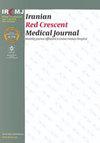Optic Nerve Sheath Diameter Affected by Cervical Collar Placement in Minor Head Trauma Patients
IF 0.2
4区 医学
Q3 MEDICINE, GENERAL & INTERNAL
引用次数: 2
Abstract
Background: Head trauma may cause an increase in intracranial pressure (ICP). The use of ocular ultrasound to measure optic nerve sheath diameter (ONSD) is a method to determine the ICP. The use of the rigid cervical collar in head trauma patients contribute to elevating ICP, and therefore, potentially causing further deterioration in their condition. Objectives: This study aimed to describe changes in ONSD after the placement of a c-collar and analyze these changes depending on the time in the c-collar. Methods: This prospective study measured the ONSD of minor head trauma patients before and after the placement of a c-collar. Patients aged ³18 with blunt head trauma and Glasgow Coma Score ³13 were included in the study. Each eye was scanned twice. This was done before c-collar placement, at 5 and 20 min after placement. The mean values of both eyes were calculated and analyzed. Results: This study investigated 50 patients. The mean baseline ONSD was obtained at 4.71mm±0.22 (4.54-4.77). Furthermore, T5 and T20 measurements were 5.19±0.41 (5.07-5.31) and 5.26±0.45 (5.14-5.39), respectively. The ONSD increased at T5 and T20. The changes from the baseline measurements were statistically significant (P=0.000, P=0.000). The difference between T5 and T20 groups was an increase in ONSD, and these differences were also statistically significant (0.07±0.19; P=0.008). Conclusion: Our results revealed that minor head trauma patients using a c-collar may increase ONSD by timeline the clinical effects of which have to be determined with further studies. Enlargement in ONSD should be considered when interpreting ICP.轻度头部外伤患者颈套置放对视神经鞘直径的影响
背景:头部创伤可能导致颅内压(ICP)升高。使用眼部超声测量视神经鞘直径(ONSD)是确定ICP的一种方法。在头部创伤患者中使用刚性颈环有助于提高ICP,因此可能导致他们的病情进一步恶化。目的:本研究旨在描述放置c形项圈后ONSD的变化,并分析这些变化随c形项圈放置时间的变化。方法:这项前瞻性研究测量了轻度头部创伤患者放置c型项圈前后的ONSD。年龄为18岁的钝性头部创伤患者和格拉斯哥昏迷评分为13的患者被纳入研究。每只眼睛被扫描两次。这是在放置c领之前、放置后5分钟和20分钟进行的。计算并分析双眼的平均值。结果:本研究调查了50例患者。平均基线ONSD为4.71mm±0.22(4.54-4.77)。此外,T5和T20测量值分别为5.19±0.41(5.07-5.31)和5.26±0.45(5.14-5.39)。ONSD在T5和T20时增加。与基线测量相比变化具有统计学意义(P=0.000,P=0.000)。T5组和T20组之间的差异是ONSD增加,这些差异也具有统计学意义(0.07±0.19;P=0.008)。解释ICP时应考虑扩大ONSD。
本文章由计算机程序翻译,如有差异,请以英文原文为准。
求助全文
约1分钟内获得全文
求助全文
来源期刊

Iranian Red Crescent Medical Journal
MEDICINE, GENERAL & INTERNAL-
CiteScore
1.16
自引率
0.00%
发文量
0
期刊介绍:
The IRANIAN RED CRESCENT MEDICAL JOURNAL is an international, English language, peer-reviewed journal dealing with general Medicine and Surgery, Disaster Medicine and Health Policy. It is an official Journal of the Iranian Hospital Dubai and is published monthly. The Iranian Red Crescent Medical Journal aims at publishing the high quality materials, both clinical and scientific, on all aspects of Medicine and Surgery
 求助内容:
求助内容: 应助结果提醒方式:
应助结果提醒方式:


